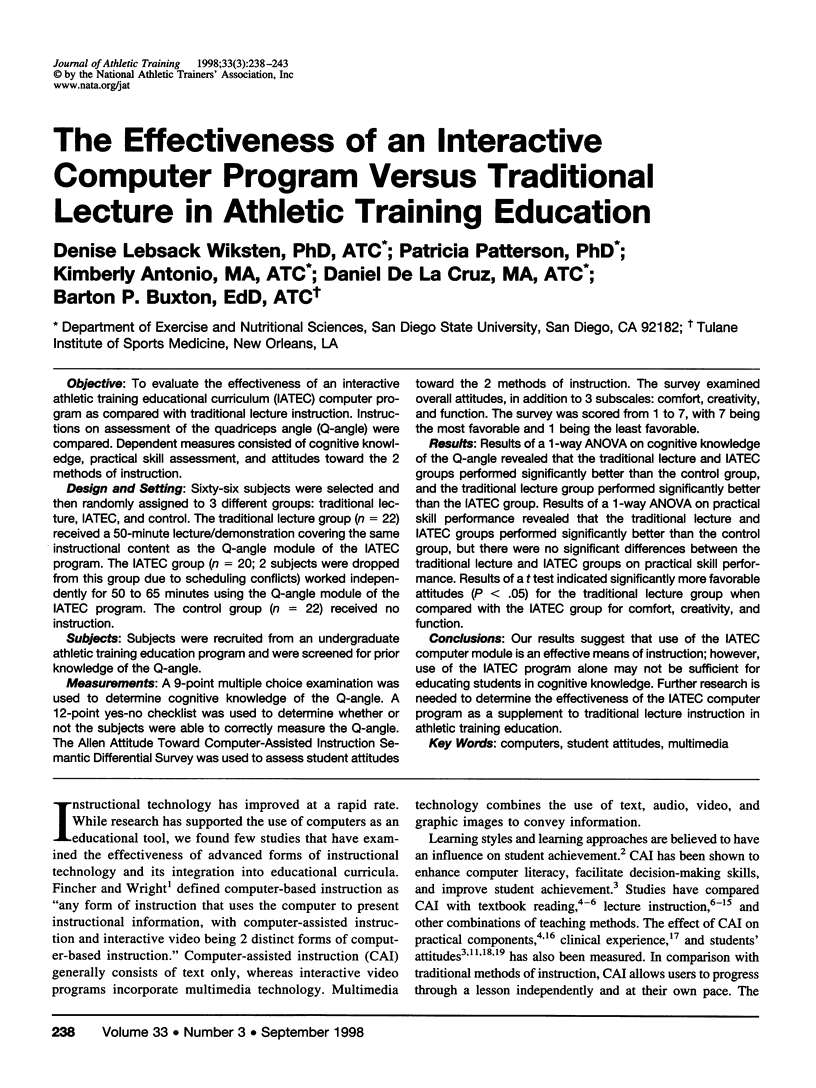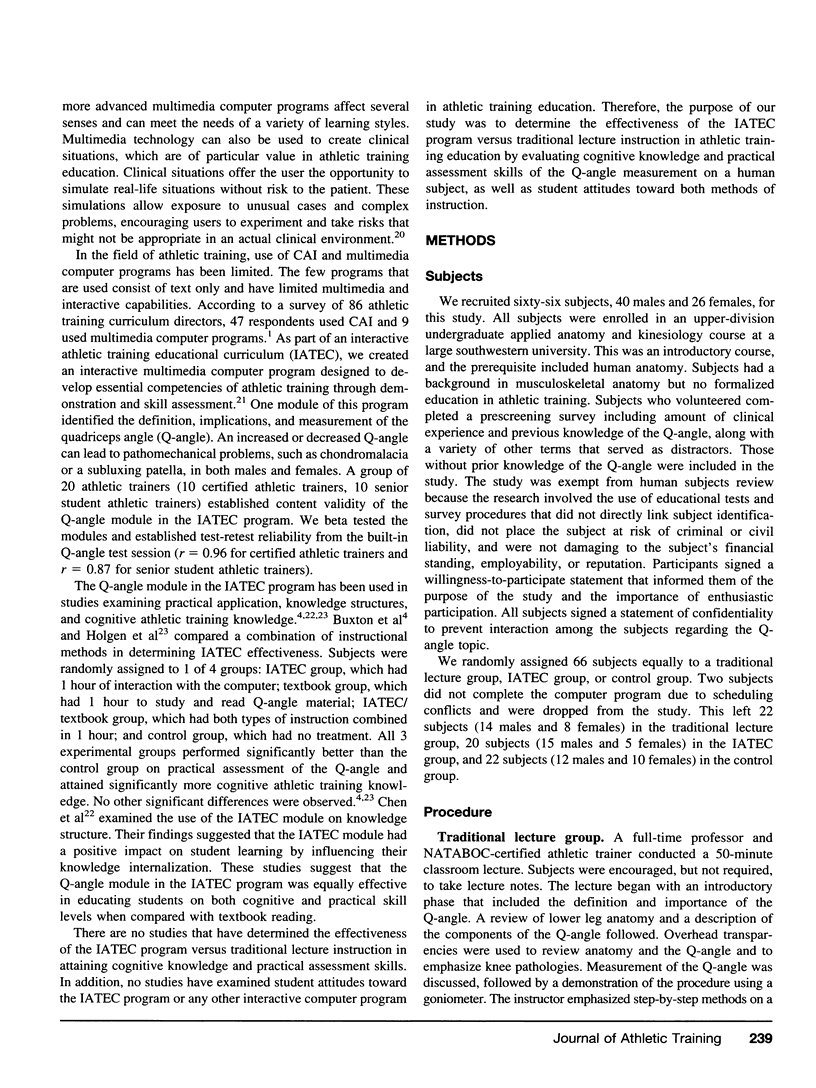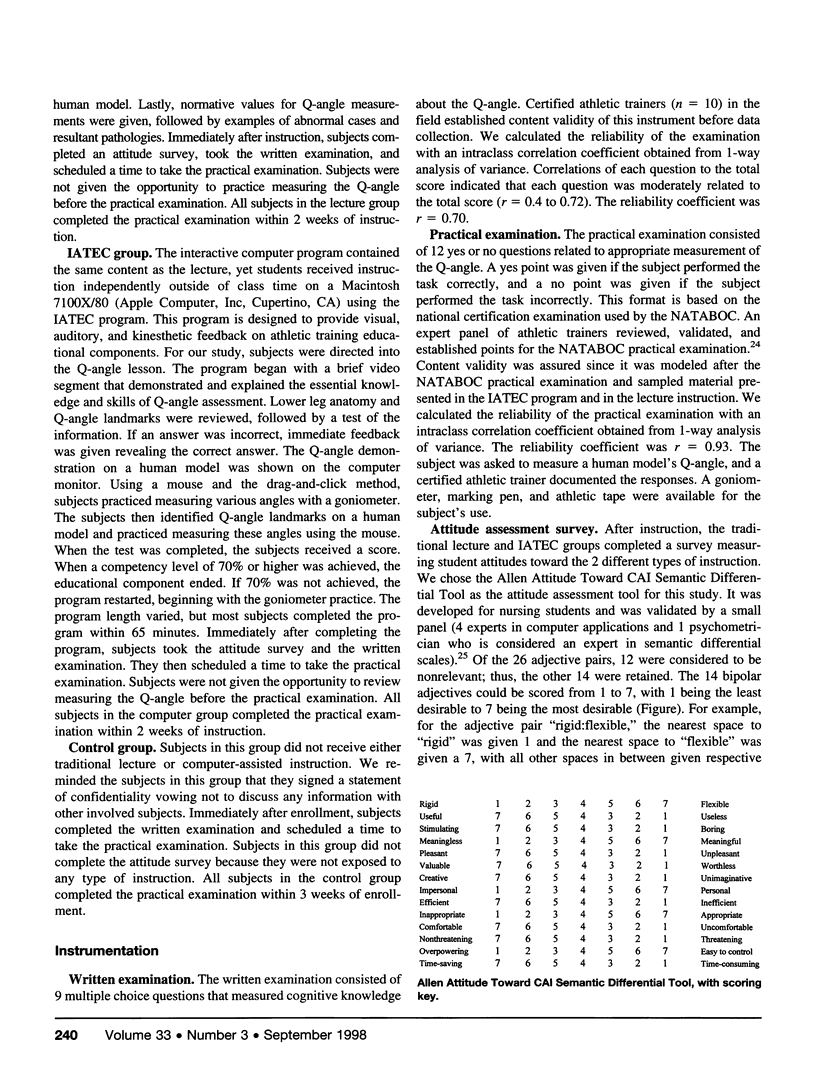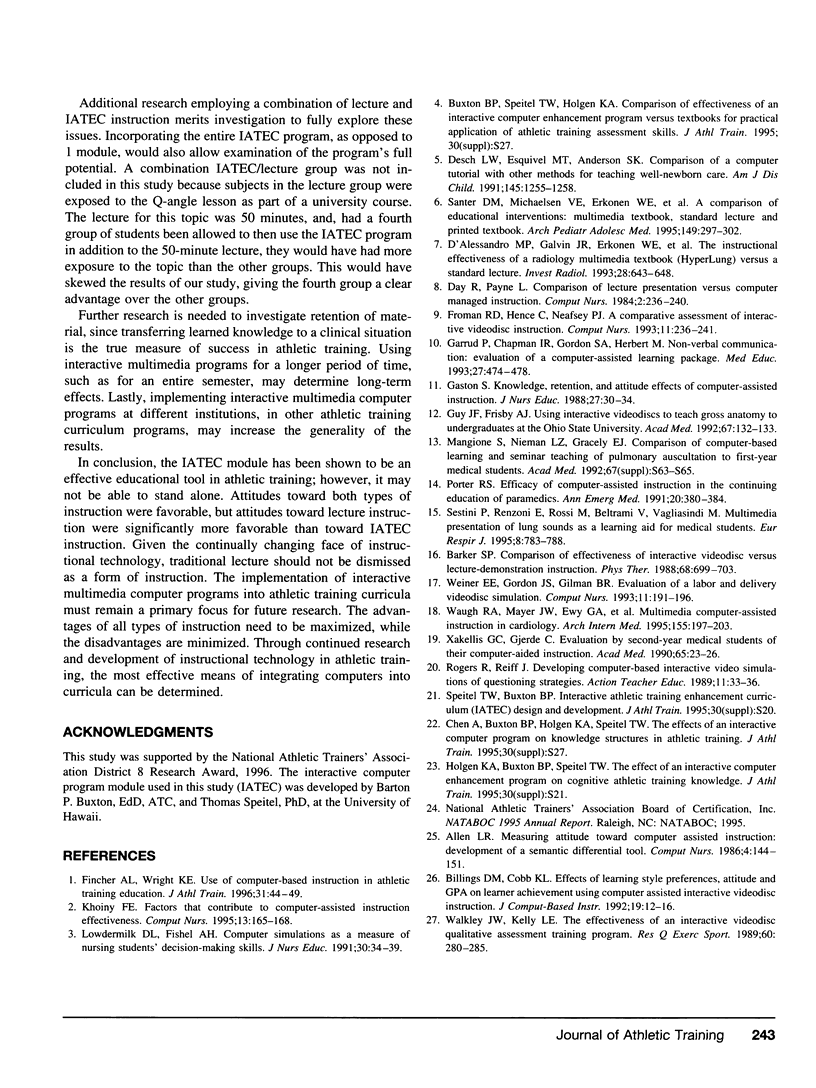Abstract
Objective:
To evaluate the effectiveness of an interactive athletic training educational curriculum (IATEC) computer program as compared with traditional lecture instruction. Instructions on assessment of the quadriceps angle (Q-angle) were compared. Dependent measures consisted of cognitive knowledge, practical skill assessment, and attitudes toward the 2 methods of instruction.
Design and Setting:
Sixty-six subjects were selected and then randomly assigned to 3 different groups: traditional lecture, IATEC, and control. The traditional lecture group (n = 22) received a 50-minute lecture/demonstration covering the same instructional content as the Q-angle module of the IATEC program. The IATEC group (n = 20; 2 subjects were dropped from this group due to scheduling conflicts) worked independently for 50 to 65 minutes using the Q-angle module of the IATEC program. The control group (n = 22) received no instruction.
Subjects:
Subjects were recruited from an undergraduate athletic training education program and were screened for prior knowledge of the Q-angle.
Measurements:
A 9-point multiple choice examination was used to determine cognitive knowledge of the Q-angle. A 12-point yes-no checklist was used to determine whether or not the subjects were able to correctly measure the Q-angle. The Allen Attitude Toward Computer-Assisted Instruction Semantic Differential Survey was used to assess student attitudes toward the 2 methods of instruction. The survey examined overall attitudes, in addition to 3 subscales: comfort, creativity, and function. The survey was scored from 1 to 7, with 7 being the most favorable and 1 being the least favorable.
Results:
Results of a 1-way ANOVA on cognitive knowledge of the Q-angle revealed that the traditional lecture and IATEC groups performed significantly better than the control group, and the traditional lecture group performed significantly better than the IATEC group. Results of a 1-way ANOVA on practical skill performance revealed that the traditional lecture and IATEC groups performed significantly better than the control group, but there were no significant differences between the traditional lecture and IATEC groups on practical skill performance. Results of a t test indicated significantly more favorable attitudes (P < .05) for the traditional lecture group when compared with the IATEC group for comfort, creativity, and function.
Conclusions:
Our results suggest that use of the IATEC computer module is an effective means of instruction; however, use of the IATEC program alone may not be sufficient for educating students in cognitive knowledge. Further research is needed to determine the effectiveness of the IATEC computer program as a supplement to traditional lecture instruction in athletic training education.
Keywords: computers, student attitudes, multimedia
Full text
PDF





Selected References
These references are in PubMed. This may not be the complete list of references from this article.
- Allen L. R. Measuring attitude toward computer assisted instruction. The development of a semantic differential tool. Comput Nurs. 1986 Jul-Aug;4(4):144–151. [PubMed] [Google Scholar]
- Barker S. P. Comparison of effectiveness of interactive videodisc versus lecture-demonstration instruction. Phys Ther. 1988 May;68(5):699–703. doi: 10.1093/ptj/68.5.699. [DOI] [PubMed] [Google Scholar]
- D'Alessandro M. P., Galvin J. R., Erkonen W. E., Albanese M. A., Michaelsen V. E., Huntley J. S., McBurney R. M., Easley G. The instructional effectiveness of a radiology multimedia textbook (HyperLung) versus a standard lecture. Invest Radiol. 1993 Jul;28(7):643–648. doi: 10.1097/00004424-199307000-00017. [DOI] [PubMed] [Google Scholar]
- Day R., Payne L. Comparison of lecture presentation versus computer managed instruction. Comput Nurs. 1984 Nov-Dec;2(6):236–240. [PubMed] [Google Scholar]
- Desch L. W., Esquivel M. T., Anderson S. K. Comparison of a computer tutorial with other methods for teaching well-newborn care. Am J Dis Child. 1991 Nov;145(11):1255–1258. doi: 10.1001/archpedi.1991.02160110047018. [DOI] [PubMed] [Google Scholar]
- Fincher A. L., Wright K. E. Use of computer-based instruction in athletic training education. J Athl Train. 1996 Jan;31(1):44–49. [PMC free article] [PubMed] [Google Scholar]
- Froman R. D., Hence C., Neafsey P. J. A comparative assessment of interactive videodisc instruction. Comput Nurs. 1993 Sep-Oct;11(5):236–241. [PubMed] [Google Scholar]
- Garrud P., Chapman I. R., Gordon S. A., Herbert M. Non-verbal communication: evaluation of a computer-assisted learning package. Med Educ. 1993 Nov;27(6):474–478. doi: 10.1111/j.1365-2923.1993.tb00306.x. [DOI] [PubMed] [Google Scholar]
- Gaston S. Knowledge, retention, and attitude effects of computer-assisted instruction. J Nurs Educ. 1988 Jan;27(1):30–34. doi: 10.3928/0148-4834-19880101-08. [DOI] [PubMed] [Google Scholar]
- Guy J. F., Frisby A. J. Using interactive videodiscs to teach gross anatomy to undergraduates at the Ohio State University. Acad Med. 1992 Feb;67(2):132–133. doi: 10.1097/00001888-199202000-00021. [DOI] [PubMed] [Google Scholar]
- Khoiny F. E. Factors that contribute to computer-assisted instruction effectiveness. Comput Nurs. 1995 Jul-Aug;13(4):165–168. [PubMed] [Google Scholar]
- Lowdermilk D. L., Fishel A. H. Computer simulations as a measure of nursing students' decision-making skills. J Nurs Educ. 1991 Jan;30(1):34–39. doi: 10.3928/0148-4834-19910101-09. [DOI] [PubMed] [Google Scholar]
- Mangione S., Nieman L. Z., Gracely E. J. Comparison of computer-based learning and seminar teaching of pulmonary auscultation to first-year medical students. Acad Med. 1992 Oct;67(10 Suppl):S63–S65. doi: 10.1097/00001888-199210000-00041. [DOI] [PubMed] [Google Scholar]
- Porter R. S. Efficacy of computer-assisted instruction in the continuing education of paramedics. Ann Emerg Med. 1991 Apr;20(4):380–384. doi: 10.1016/s0196-0644(05)81659-2. [DOI] [PubMed] [Google Scholar]
- Santer D. M., Michaelsen V. E., Erkonen W. E., Winter R. J., Woodhead J. C., Gilmer J. S., D'Alessandro M. P., Galvin J. R. A comparison of educational interventions. Multimedia textbook, standard lecture, and printed textbook. Arch Pediatr Adolesc Med. 1995 Mar;149(3):297–302. doi: 10.1001/archpedi.1995.02170150077014. [DOI] [PubMed] [Google Scholar]
- Sestini P., Renzoni E., Rossi M., Beltrami V., Vagliasindi M. Multimedia presentation of lung sounds as a learning aid for medical students. Eur Respir J. 1995 May;8(5):783–788. [PubMed] [Google Scholar]
- Walkley J. W., Kelly L. E. The effectiveness of an interactive videodisc qualitative assessment training program. Res Q Exerc Sport. 1989 Sep;60(3):280–285. doi: 10.1080/02701367.1989.10607451. [DOI] [PubMed] [Google Scholar]
- Waugh R. A., Mayer J. W., Ewy G. A., Felner J. M., Issenberg B. S., Gessner I. H., Rich S., Sajid A. W., Safford R. E. Multimedia computer-assisted instruction in cardiology. Arch Intern Med. 1995 Jan 23;155(2):197–203. [PubMed] [Google Scholar]
- Weiner E. E., Gordon J. S., Gilman B. R. Evaluation of a labor and delivery videodisc simulation. Comput Nurs. 1993 Jul-Aug;11(4):191–196. [PubMed] [Google Scholar]
- Xakellis G. C., Gjerde C. Evaluation by second-year medical students of their computer-aided instruction. Acad Med. 1990 Jan;65(1):23–26. [PubMed] [Google Scholar]


